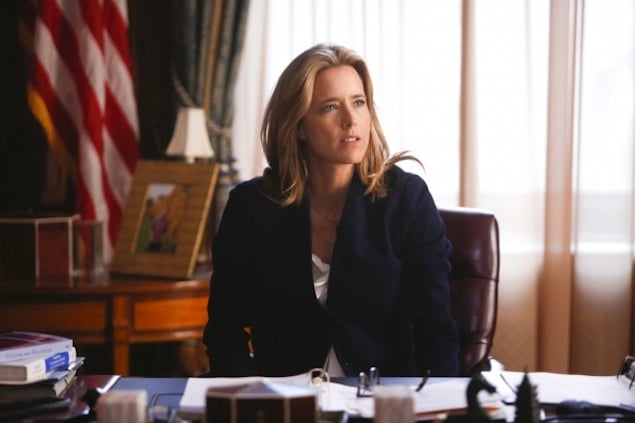Welcome to our recaps of Madam Secretary, one of two new network dramas focusing on high-powered, “maverick” Washington women. CBS’s show reunites star Téa Leoni with her Deep Impact costar Morgan Freeman, who executive-produces the series. Didn’t catch the pilot episode Sunday night? Read on to find out what you missed.
Somewhere in Damascus, two American teenagers are thrown into a jail cell. The younger one tearfully says he’s not sure what’s happening; the older one tells him their captors have said they’ll die in there. How does he know Arabic? We’ll find out later. In the meantime, we swoop over to the University of Virginia, where Dr. Elizabeth “Beth” McCord (Leoni) is being pursued by a student who wants to discuss his thesis. She’s wearing jeans and the kind of scarf that says I’m Down to Earth and Firm Yet Fair, which she proves by dealing with her student with humor and toughness (no extension for your thesis!). She then heads across campus, where her hunky husband, Henry (Tim Daly)—also a professor—is pontificating to a gaggle of rapt female students. Elizabeth interrupts him for some kinda inappropriate public makeout action, to the dismay of one especially attentive fan (do I detect an adultery subplot?), and then whisks him out the door, reminding him he has to make dinner that night because she has a “spy reunion” in DC.
Yes, it’s true: Beth used to be in the CIA, and is meeting her spy friends for dinner, where they talk about their old boss, who’s now the President—they refer to him as POTUS—and complain about how they’re being “put to pasture.” Beth says, not totally convincingly, how happy she is that all she has to worry about is grading papers and parenting; then all the spies’ phones buzz at once, and George (William Sadler) tells her the Secretary of State’s plane has gone down off the coast of Florida.
The next morning, after some banter with her children—a teenage girl and a younger boy who’s a self-proclaimed anarchist and conspiracy theorist—Elizabeth is mucking out a horse stall with her hair in pigtails. Her son comes in to say the President—“of the United States”—has been trying to call, but before she can get to the phone she hears sirens and sees a convoy outside her house. Her old friend POTUS (Keith Carradine) has arrived to strong-arm her into taking over for the recently departed Secretary of State, because she is such a maverick: “You don’t think outside the box—you don’t even know there is a box,” he tells her. He gives her the rest of the day to think it over, but we don’t need that long, since that’s kinda the whole point of the show. We also find out that Beth quit the CIA for “ethical reasons,” which seems like it might be important later on.
Flash-forward two months, and Beth is in the White House being briefed by a snippy Bebe Neuwirth on an upcoming diplomatic dinner with the King of Swaziland and his ten wives. Beth’s quirky lineup of staffers also includes Geoffrey Arend, House of Cards’ Sebastian Arcelus, and the excellently dry Erich Bergen. Elizabeth isn’t especially interested in photo ops with polygamist kings; she’s more worried about the two kidnapped teenagers who are apparently about to be executed in Syria. She briefs the Chief of Staff, Russell Jackson (played by True Blood’s Zeljko Ivanek), on the situation, and says she wants to use her old CIA connections to rescue the kids by unofficial means. He insists they do everything his way and also, insultingly, tells her he’s hired her a stylist, which she rejects outright.
Naturally, the official operation fails, and the parents of the kids, against Beth’s express instructions, give a two-hour interview to the New York Times. To avoid the interview being splashed across the front page, Beth awesomely distracts the press by getting the stylist to give her a makeover (also a nice commentary on the state of cable news). She also sets up a meeting with the President—by texting his wife, whom she’s still sort of friends with—and convinces him to let her rescue the kids her way, which involves a Russian guy, $1 million in aid, and Beth delivering the line “No one misses Syria if it completely self-destructs.” The kids make it home—miraculously with almost no media attention—and while the Chief of Staff is none too pleased that Beth circumnavigated his authority, they appear to reach an uneasy truce.
Have you been missing the conspiracy-theory element? Never fear, it’s included: Beth and Henry are discussing her Russell Jackson problem at home, when George shows up, visibly upset and babbling about her house being bugged. He tells her the Secretary of State’s plane crash was not an accident—he had been headed to Caracas, Venezuela, at the time, and George found out he had some shady business dealings there. George is about to say more, but then Henry comes downstairs and he gets even twitchier and leaves as suddenly as he arrives, so you know he’s probably going to die horribly.
Beth heads to her dinner with the King of Swaziland, his wives, and all her staffers. She makes a joke about only having one husband, and her staffers get bug-eyed, but luckily he finds her amusing, and she uses his good humor to talk about how they want to work with him to help end the AIDS epidemic in his country—with the help of his wives, whom she addresses one at a time by name. The dinner is a smash success, impressing even Bebe Neuwirth, but Beth has no time to bask in her success. She gets back to her office to find Henry, who tells her George was killed when his car crashed into a telephone pole. “That wasn’t an accident,” Beth says. “I know,” says Henry.
Some questions: Who’s behind these mysterious deaths, and could Henry be in on the conspiracy? Why is Russell Jackson so hell-bent on antagonizing Beth? What were her “ethical reasons” for quitting the CIA? Let us know what you thought of Madam Secretary in the comments, and tune in next week for another recap.
For more arts and entertainment coverage, follow After Hours on Twitter at @afterhoursblog.
















